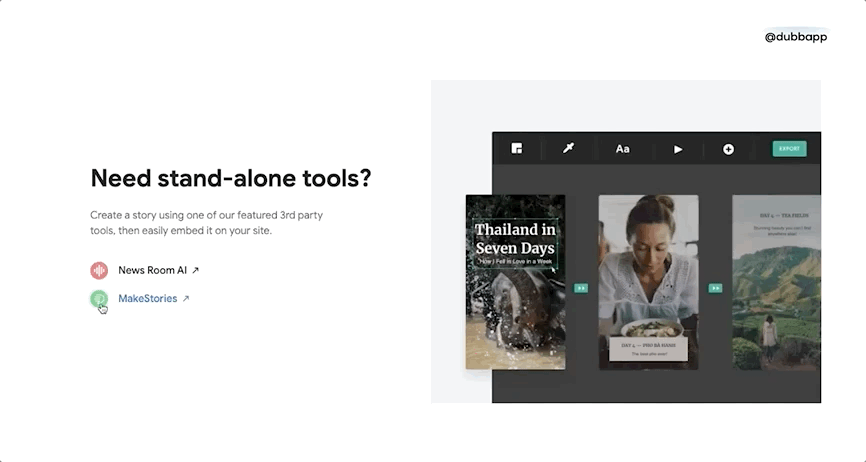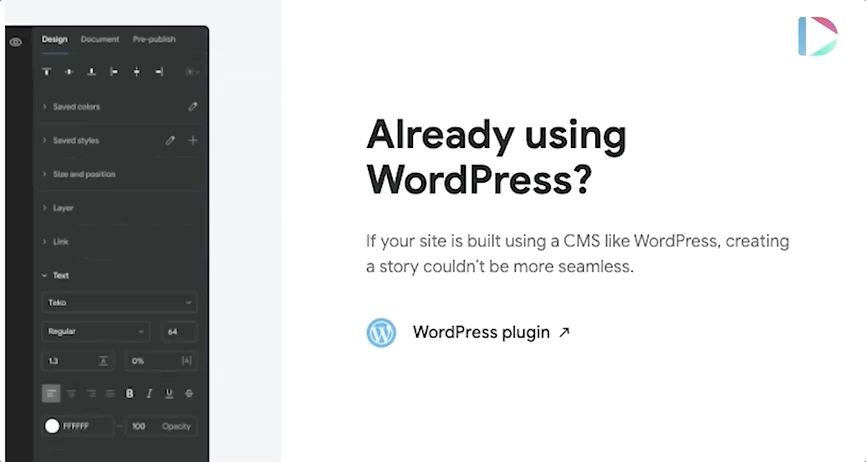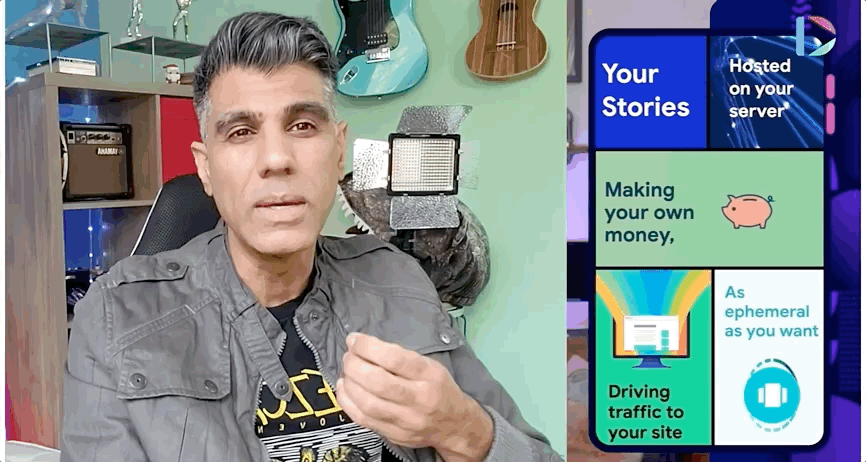Google Web Stories are the latest tool that can help you build closer connections with your digital audiences. That being said, you may not be certain about what they are, how you can make them, and why you should make them in the first place.
If you have any of these questions, you are in luck. In this post, I want to take a deep dive into Google Web Stories and how they can help your business. Whether you just started your own startup or are looking for new ways for your business to connect with your audience, you’ll definitely want to invest some time into learning about this new tool.
Note: this post is not sponsored by Google. We are just highlighting an awesome new product that we think Dubb users will enjoy!

The Sudden Rise of Instant Videos
As you will quickly see, Google Web Stories is a recent iteration of the many types of “story tools” that are in the market today. Arguably, the first web story feature was found on Snapchat. Snapchat Stories were, and still are, a great way to create quick, ephemeral content that you could share with your audience members. From Snapchat Stories, we have come to know and love tools like Instagram Stories and TikTok. Even Twitter released a new feature called Fleets, which lets Twitter users share stories like they would on Instagram Stories. Now, you can’t go on social media websites and avoid seeing the stories of family members, friends, and even corporations.
So this naturally leads to the question of why instant videos are so popular. I think it comes down to the immediacy of these videos. Instead of creating well-produced, sleek videos for audience members, these instant videos are quicker and more authentic. If you are the creator, all you really need to do is take out your phone and start recording. Better yet, you can be anywhere when you record these videos. You can create an instant video when you are sitting down at your desk or when you are going out on a run. Before Covid-19, you could even interview compelling guests at a conference or in-person event.
No matter the content of your videos, these videos create deep-seated trust with members of your audience. They can show off your personality and the way that you think about the world. Even if you make mistakes or don’t say everything that is on your mind, instant videos can be extremely effective. Whether you are trying to build more brand awareness for your company or generate more sales, instant videos can get the job done.
Google’s Foray Into Instant Videos
While there are likely plenty of reasons behind the decision, Google’s foray into instant videos shows the format’s staying power. That being said, it appears that Google is looking to take this one step further. Specifically, it is trying to create an open story format for the entire Internet.
Google Web Stories are giving users a powerful way to make creative visual narratives with all sorts of features. Those features include engaging animations, tappable interactions, customizable monetization options, and so much more. Better yet, theses stories immerse viewers with fast loading pages. It is a seamless experience that your audience members will definitely love. Along with this, Google Web Stories provide some detailed analytics. You can track and measure your stories, which can help you better devote time and resources to accomplish your marketing goals.
It’s almost like Google is creating a format that will plug into the entire Google ecosystem. But at its core, Google Web Stories integrates content that we’re used to. This includes things like blog posts and videos. This new tool gives creators the tools to create dynamic, 9×16, totally-mobile friendly snippets of content that their users can enjoy.
Google Web Stories are still really new. Your audience may be coming across them for the first time. You could actually see a world where Google prefers the story format in Google search results. They may highlight your stories when users are searching for specific keywords.
The company hasn’t done this yet, but it is important to keep it in mind as Google Web Stories become more prominent. We have seen other social media platforms promote content that includes new features or tools. Instagram and Facebook are the primary examples here. Creators were incentivized to make Stories and Lives, as both platforms made it more likely that these pieces of content were seen by more people.
Google is known to test things out when it is launching new products or services. Sometimes those products succeed. Other times, these products are discontinued a few years later.
At this point, we don’t know the future course of Google Web Stories. While there’s nothing you need to necessarily do right now, there may come a time where there are even more incentives to include these stories in your digital marketing work. Therefore, even if you are just hearing about Google Web Stories for the first time, you should, at the very least, continue to monitor its development in the coming months and years.

Several Third-Party Services to Help You Leverage This New Tool
There is one caveat in this entire discussion, however. Importantly, Google itself is not creating the tools that you would expect. Rather, it is more like Google is creating the structure and format. Google is also providing the documentation for the code, making it easy for developers and those more technically-oriented to use Google Web Stories in any way that they want.
But what about those of us that are technical novices or don’t like to look at the underlying code? There is good news. Third-party developers are creating the design tools to let anyone create these types of stories. These third-party services let your less technically-inclined colleagues leverage everything that Google Web Stories have to offer.
As Google Web Stories become more popular, there are going to be plenty of third-party tools that you can use. However, at the moment, there is one service that lets you create Google Web Stories in a graphical interface. That service is called MakeStories. Like Google, we aren’t affiliated with MakeStories. That being said, we think it is a great tool for non-technical creators that want to leverage Google Web Stories.
MakeStories is a company that lets you build web stories (also known as AMP Stories) extremely quickly. Better yet, MakeStories is a drag drop, zero code builder. No coding or programming skills are necessary. Moreover, you can take advantage of over 75 features to make stories that are customized for your needs. Things like royalty-free stock images, icons, illustration shapes, and more can accelerate your story building and create more compelling videos.

But along with MakeStories, you can take advantage of a plugin that Google itself created for Google Web Stories. That plugin for WordPress. There is a good chance that your website is built on WordPress. If this is the case, you can leverage this plugin to easily use Google Web Stories in your work.
As you can see on the plugin’s page, this plugin is technically labeled as the Web Stories editor for WordPress. With this plugin, you can leverage everything from a visually rich and intuitive dashboard and beautiful page templates to color and text style presets. Because this is a WordPress plugin, you can easily download it and install it onto your WordPress website. With over 20,000 active installations, this plugin can be a great way to incorporate Google Web Stories on your WordPress website. If you are looking for more guidance on how to create stories through this plugin, this is a great guide.

But even if you don’t have a WordPress website, you can use third-party services like MakeStories to create these types of stories. Once you are finished, you can then take those Google Web Stories and then embed them onto your website. You would actually have to host those stories on your site. That being said, MakeStories and other third-party services are making it easier to create and produce this type of content.
Important Problems that Google Web Stories Solve
So considering all of these ways that you can use Google Web Stories, it is also important to think about why Google Web Stories is so powerful. In other words, what types of problems can Google Web Stories solve?
Ultimately, there are many.
The first problem that these stories solve is related to our short attention span. We all have it—even if we don’t want to admit it. In today’s day and age, it is all too easy to look for that next video or that next piece of content that will entertain us. Related to this, it has become much more difficult to consume longer types of content. It isn’t impossible (look at how Joe Rogan has built the number one podcast through two and three-hour episodes). That being said, you have to create really stellar content to keep your audience’s attention for that long.
So back to Google Web Stories. Essentially, this tool lets you create outstanding content that can suit your audience’s short attention span. This is because, at their core, these stories are short snippets of information that you can consume in between moments. These moments can be plenty, whether you are having a cup of coffee or are taking a break at work. Because they are short snippets of information, they are easily consumable throughout the day. Members of your audience can sneak them in during those slower points of the day.
The second problem that Google Web Stories solve is the immediacy and relevancy relationship. It’s pretty simple. The more immediate that a piece of content is, the more irrelevant it is.
Here’s an example. Let’s say that you want to share a quick update in your professional life. Maybe you are celebrating the five-year anniversary of your company’s founding. You can quickly capture that moment. The quality may not be that great, but you are sacrificing quality for immediacy here. The point is to get that video recorded and quickly distribute it to your followers and fans. By doing this, you can get engagement and build relationships with your audience members.
Now conversely, you can make videos that are less instant or less immediate. If you have more time for a less immediate topic, that video can go through several rounds of production. This can include everything from copywriting and the creation of your video to editing. With these types of video, it doesn’t really matter whether they get posted immediately or in a few days. This is because this type of video is evergreen content. In other words, you can think of evergreen content as continually relevant content that remains “fresh” in the eyes of your audience.
Ultimately, Google Web Stories gives us the best of both worlds. We can get immediate content. This immediate content is both easy to create and easy to consume. Google does this in a way that is virtually better than any other company. Google’s algorithm can easily figure out what content is immediate and what content is more relevant on a long-term basis. As a content creator, this is an extremely helpful feature. It can help you get your great content in front of all types of audiences, which thereby lets you increase your chances of generating more sales.

Google Web Stories is an outstanding way to attract mobile users. We all recognize the trends in Internet use. More traffic is coming from mobile traffic than desktop traffic. Even if you don’t have a self-defined mobile app, your company needs to think about ways to engage with your mobile users.
This is where Google Web Stories can be extremely valuable. With Google Web Stories, you can create extremely attractive content for your mobile users. Because Google Web Stories are a new form of Accelerated Mobile Pages (“AMP”), they are well-suited to be consumed on mobile devices. In other words, they are purposely designed to be consumed at a glance.
Therefore, I encourage you to use Google Web Stories if you want to grow your mobile audience. They can help you build relationships with your audience members that are on-the-go.
Finally, Google Web Stories are great ways for you to build your organization’s SEO. Like I discussed above, there may come a time when Google Web Stories will become a critical part of any organization’s SEO strategy. While that time isn’t necessarily right now, Google Web Stories can already help you build strong SEO. This is because Google Web Stories are extremely quick to load, have high time on-site, and have low bounce rates. Along with this, Google Web Stories are easily shareable, which can also help you rise up the search rankings.
Because of this, take a look at Google Web Stories if you want to improve your organization’s SEO. While there is no guarantee, doing so will substantially increase your chances of rising up the search rankings and generating more organic leads.
Take Advantage of This New Tool
Like any new tool, Google Web Stories has its nuances. It’ll likely take you some time to get used to them. But when you do, I’m sure that you’ll see the value that they can bring to your organization. In the end, it is worth your time to learn about and include this awesome new tool in your marketing work.
When creating Google Web Stories, we also invite you to use Dubb. Dubb offers many different tools and features that can help you accelerate our video marketing work. To learn more about how Dubb can help you, click here. You can also click here to get in touch with us or click here to sign up for a free 14-day trial.


